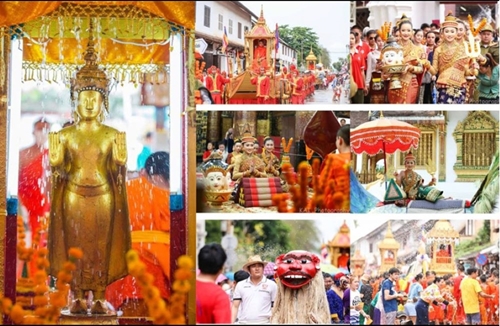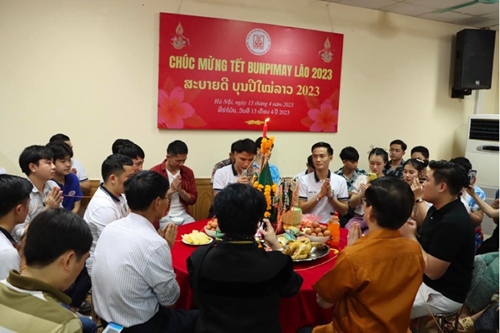For the Lao people, the traditional New Year festival, also known as Bunpimay, takes place in April. It means bringing prosperity to all, and happiness and peace to people.
    |
 |
|
Many activities are held during the four-day Bunpimay festival. |
Annually, Lao people spend four days celebrating Bunpimay festival, from April 13 to 16 of the solar calendar. This is also the hottest time of the year.
On these days, all corners are cleaned up and houses are decorated with Champa and Cassia fistula flowers. Cassia fistula, also known as Dok Khoun in Laos, is a yellow-colored flower with a light scent and blooms during the festival. Bunches of Dok Khoun are tied with thread and hung on house doors, bringing the message of luck and happiness. They are also hung on cars and motorbikes to wish for safe long trips.
During the Bunpimay festival, Lao people participate in many community activities. On the occasion, traditional customs are often held in temples or at home such as: Buddha bathing ritual, tying threads on wrists, releasing animals, and sending best wishes to parents and grandparents, among others.
    |
 |
|
Tying threads on the wrist and sending best wishes to each other |
Traditionally, on the first day of the festival, also known as Sang Khan Luang, a day to say goodbye to the old year and welcome the New Year, the Lao people usually clean up their houses and prepare fragrant water. It is a mixture consisting of water, turmeric, locust, flowers and essential oils. It is flavored with flowers such as Champa or Dok Khoun. On this day, Buddha statues in temples in Laos are taken to the temple grounds and bathed with fragrant water by local people.
The second and third days of Bunpimay festival are so-called Van Nao or the New Year Eve. On these days, children, together with their parents and grandparents, join the water blessing festival. They are all wish for happiness and send best wishes to each other. They believe that the custom will help them get rid of bad things of the old year, and prepare for a better New Year.
On the last day of the traditional Bunpimay festival, also known as Khuen Py May, many families take part in Baci ceremony, involving the tying of white cotton strings around a person’ wrist, to welcome the New Year, and present gifts to the elderly and ask for forgiveness for what they did not do well in the previous year.
In the afternoon or evening of Khuen Py May, the Buddha statue in the temple is brought back inside. People come to listen to the chanting of sutras to ask for Buddha’s forgiveness if they accidentally touch the statue during the Buddha bathing ritual. They hold a candlelight and walk around the temple to conclude Bunpimay festival.
Nowadays, during the traditional Bunpimay festival, in big cities, there are many people splashing water all over each other, so the traditional New Year festival in Laos is also known as Bun Hout Nam (water splashing festival).
    |
 |
|
Lao people gather at pagodas to participate in the Buddha bathing ritual. |
One of the best and traditional dishes is “Laap,” also spelled as lahp or larb. It is essentially a salad with a meat base, flavored with lime, garlic, fish sauce, mint leaves, spring onion and ground toasted rice. Even businessmen consider “Laap” a fortune.
Additionally, during the festival, people often travel, eat “Laap,” drink Lao beer, sing, dance and splash water to send new year greetings to each other.
Visiting Laos on the occasion of Bunpimay festival, visitors not only have a chance to get to know more about the country of peace and beauty, but also experience the water splashing custom, and understand more about the Lao people.
Translated by Minh Anh